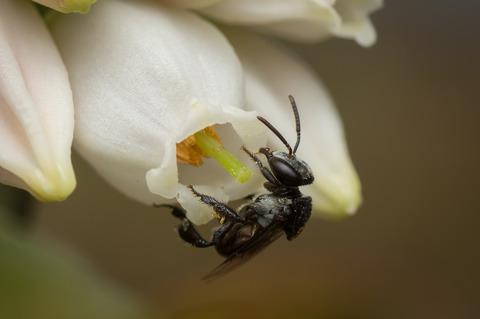当前位置:
X-MOL 学术
›
J. Appl. Ecol.
›
论文详情
Our official English website, www.x-mol.net, welcomes your feedback! (Note: you will need to create a separate account there.)
Self‐compatible blueberry cultivars require fewer floral visits to maximise fruit production than a partially self‐incompatible cultivar
Journal of Applied Ecology ( IF 5.7 ) Pub Date : 2020-09-30 , DOI: 10.1111/1365-2664.13751 Liam K. Kendall 1, 2 , Vesna Gagic 2 , Lisa J. Evans 3 , Brian T. Cutting 3 , Jessica Scalzo 4 , Yolanda Hanusch 5 , Jeremy Jones 1 , Maurizio Rocchetti 4 , Carolyn Sonter 1 , Matthew Keir 3 , Romina Rader 1
Journal of Applied Ecology ( IF 5.7 ) Pub Date : 2020-09-30 , DOI: 10.1111/1365-2664.13751 Liam K. Kendall 1, 2 , Vesna Gagic 2 , Lisa J. Evans 3 , Brian T. Cutting 3 , Jessica Scalzo 4 , Yolanda Hanusch 5 , Jeremy Jones 1 , Maurizio Rocchetti 4 , Carolyn Sonter 1 , Matthew Keir 3 , Romina Rader 1
Affiliation

|
Effective pollination is a complex phenomenon determined by the outcome of the interaction between pollen transfer and a plants' pollinator dependency, yet most studies investigate pollinator effectiveness without consideration of plant mating system differences. We investigated pollinator effectiveness in three types of blueberry that differed in their degree of pollinator dependency as measured by plant mating system: two self-compatible highbush cultivars and one partially self-incompatible rabbiteye cultivar. We quantified pollinator effectiveness as a function of the fruit set and fruit weight resulting from single and multiple floral visits (2–15 visits), in comparison with estimates of fruit set and fruit weight resulting from experimental pollination treatments (open-pollination, cross-pollination and self-pollination). Single-visit effectiveness of fruit set was similar across pollinator taxa but considerably higher in both self-compatible cultivars. The probability of fruit set in all three blueberry types improved in response to an increasing number of visits, but this relationship was steeper in self-compatible cultivars: >90% probability of fruit set was achieved in three to five visits. In the self-incompatible rabbiteye cultivar, 58% fruit set was achieved with 15 visits. Multiple visits improved fruit weight by 27%–48% in self-compatible cultivars, but there was no relationship in rabbiteye. Pollination deficits in fruit set and fruit weight due to self-pollination were most pronounced in rabbiteye. Synthesis and applications. Improved understanding of cultivar-level mating system differences in plants will inform pollination planning and management in agroecosystems. Self-compatible (highbush) cultivars require less floral visitation to maximize fruit production. Therefore, these cultivars may be best suited to landscapes in which pollinator abundance is low, such as intensive and/or simple landscapes. In contrast, self-incompatible (rabbiteye) cultivars may benefit from the implementation of mixed-cultivar crop row plantings to facilitate cross-pollination. (Less)
中文翻译:

与部分自相不相容的品种相比,自交的蓝莓品种需要更少的花卉访问来最大限度地提高果实产量
有效授粉是一种复杂的现象,由花粉转移和植物对传粉媒介的依赖性之间的相互作用的结果决定,但大多数研究调查传粉媒介的有效性,而不考虑植物交配系统的差异。我们研究了三种蓝莓的传粉效率,这些蓝莓的传粉媒介依赖程度不同,这取决于植物交配系统:两种自交高灌木品种和一种部分自交不相容的兔眼品种。我们将授粉者的有效性量化为单次和多次开花(2-15 次访问)产生的坐果和果实重量的函数,与实验授粉处理(开放授粉、交叉授粉)产生的坐果和果实重量的估计值进行比较。授粉和自花授粉)。在授粉昆虫分类群中,坐果的单次访问效率相似,但在两个自交栽培品种中的结果要高得多。随着访问次数的增加,所有三种蓝莓类型的坐果概率都有所提高,但这种关系在自交栽培品种中更为陡峭:在三到五次访问中实现了 >90% 的坐果概率。在自交不相容的兔眼品种中,15 次访问实现了 58% 的坐果率。多次访问使自交品种的果实重量提高了 27%–48%,但在兔眼中没有关系。由于自花授粉导致的坐果和果实重量的授粉缺陷在兔眼中最为明显。合成与应用。提高对植物品种级交配系统差异的理解将为农业生态系统的授粉规划和管理提供信息。自相容(高丛)栽培品种需要较少的花卉访问以最大限度地提高水果产量。因此,这些品种可能最适合传粉媒介丰度低的景观,例如密集和/或简单的景观。相比之下,自交不相容(兔眼)栽培品种可能受益于实施混合栽培品种作物行种植以促进异花授粉。(较少的)自交不相容(兔眼)栽培品种可能受益于实施混合栽培品种作物行种植以促进异花授粉。(较少的)自交不相容(兔眼)栽培品种可能受益于实施混合栽培品种作物行种植以促进异花授粉。(较少的)
更新日期:2020-09-30
中文翻译:

与部分自相不相容的品种相比,自交的蓝莓品种需要更少的花卉访问来最大限度地提高果实产量
有效授粉是一种复杂的现象,由花粉转移和植物对传粉媒介的依赖性之间的相互作用的结果决定,但大多数研究调查传粉媒介的有效性,而不考虑植物交配系统的差异。我们研究了三种蓝莓的传粉效率,这些蓝莓的传粉媒介依赖程度不同,这取决于植物交配系统:两种自交高灌木品种和一种部分自交不相容的兔眼品种。我们将授粉者的有效性量化为单次和多次开花(2-15 次访问)产生的坐果和果实重量的函数,与实验授粉处理(开放授粉、交叉授粉)产生的坐果和果实重量的估计值进行比较。授粉和自花授粉)。在授粉昆虫分类群中,坐果的单次访问效率相似,但在两个自交栽培品种中的结果要高得多。随着访问次数的增加,所有三种蓝莓类型的坐果概率都有所提高,但这种关系在自交栽培品种中更为陡峭:在三到五次访问中实现了 >90% 的坐果概率。在自交不相容的兔眼品种中,15 次访问实现了 58% 的坐果率。多次访问使自交品种的果实重量提高了 27%–48%,但在兔眼中没有关系。由于自花授粉导致的坐果和果实重量的授粉缺陷在兔眼中最为明显。合成与应用。提高对植物品种级交配系统差异的理解将为农业生态系统的授粉规划和管理提供信息。自相容(高丛)栽培品种需要较少的花卉访问以最大限度地提高水果产量。因此,这些品种可能最适合传粉媒介丰度低的景观,例如密集和/或简单的景观。相比之下,自交不相容(兔眼)栽培品种可能受益于实施混合栽培品种作物行种植以促进异花授粉。(较少的)自交不相容(兔眼)栽培品种可能受益于实施混合栽培品种作物行种植以促进异花授粉。(较少的)自交不相容(兔眼)栽培品种可能受益于实施混合栽培品种作物行种植以促进异花授粉。(较少的)



























 京公网安备 11010802027423号
京公网安备 11010802027423号